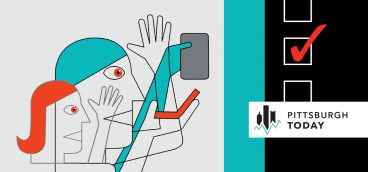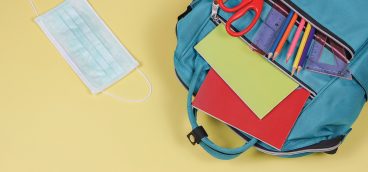On a quiet afternoon inside Seville Elementary School’s modest, unprepossessing building in Pittsburgh’s northern suburb of Ross, something electric is happening—literally and figuratively.
The subject at hand is electricity: what it is and how to create it. But there’s a charge in the atmosphere, too, the kind that might make the hair on parents’ necks stand on end as their rapt third graders shoot up their hands at every question from science teachers Tom Welch and Kathy Weber.
At each round table, students peer at a green plastic circuit board laced with a few wires and a tiny light bulb and a switch. The question of the day: Which test object will complete the circuit and create an electric current? Would a plastic straw work to connect all the parts? A pencil? A nail?
Suddenly, an “oooh” floats up in the middle of the room. Then another, and another, as from table to table, the children discovered that the metal nail, indeed, is the magic ingredient in making electricity.
But this is not magic. It is science as it should be: inquiry-based, “hands-on” science that doesn’t stop at “hands-on.” Here, at Seville, the kids know what they’re learning. In the days and weeks before the experiment, they tease apart the subject of electricity — what happens when you put a plus charge and a minus charge together, for example, or why an electric current won’t flow through an open-ended circuit. They focus, they explore, they reflect, they apply. They investigate and record what they observe. And then, afterwards, they talk and write some more.
And when test time comes around, many of those students — at Seville and at other schools in southwestern Pennsylvania — will outperform their peers elsewhere in the state, and nationally and internationally, too. Some students will even outscore their peers from Singapore and Japan.
All of this represents the triumph of an idea that germinated nearly 15 ago, when officials at Bayer Corp., dismayed by American students’ lagging test scores in science, held a brainstorming session.
“We’re a science and research based company, our livelihood depends on innovators who are interested in science and a pool of knowledgeable workers from which to pull,” says Rebecca Lucore, Bayer’s manager for community affairs. “And we started to see all this data and it was not good.”
So, with seed money from the Bayer Foundation and other philanthropic organizations, as well as several large National Science Foundation grants in the mid-1990s, ASSET Inc., was born.
Its founding idea was simple: teachers don’t ever stop learning, but they need help — not only with high quality materials and lesson plans but with ongoing support. If teachers get a question they can’t answer, or if they ever suspect they’re not teaching the material correctly, all they have to do is pick up the phone. They call ASSET, based on the South Side, which will provide coaching, assistance, and, if needed, ASSET staffers will travel to the school, where they might help a teacher set up a new “module,” review the student’s tests or suggest a better way to ask a question.
“We don’t just give the school districts the material and say ‘go forth and prosper,’” says Reeny Davison, ASSET’s executive director. “We’re a wrap-around program that includes lots of training on a constant basis.”
Today, ASSET is a remarkable success story in the field of elementary science education, growing from just two school districts to 16, then 30, then 48. Students in the 16 districts involved in ASSET since its inception in 1992 have outperformed their peers throughout the United States and around the world on 4th to 7th grade science tests. And in March, Horizon Research, Inc., a nationally known education research firm, cited ASSET as one of the best models in the country for local systemic change.
Its track record has not gone unnoticed in Gov. Ed Rendell’s office, which proposed $10 million in the 2006-2007 budget to expand ASSET’s program to 150 school districts statewide.
The project married a good idea with strong financial support from Pittsburgh foundations as well as corporations, most notably Bayer, Westinghouse and Equitable Resources.
“It really grabbed our attention that they had this group of kids that performed as well as their peers elsewhere, even internationally,” says Amy Slamp, director of the Pennsylvania Department of Education’s Bureau of Teaching and Learning.
“With those kinds of results, we knew this was something we had to have in as many schools in Pennsylvania as possible.”
Moreover, today’s methods of teaching science have evolved beyond just reading what’s in textbooks and occasionally dissecting a frog or two. “Asking questions of the students? That’s not how we were trained to teach,” said Ms. Slamp. “But in the 21st century, it’s a much more collaborative, communicative process. ASSET is designed to help people do something they’ve never done, to ‘re-teach’ them how to teach science.”
Teacher “coaching” as a whole is a relatively new educational phenomenon, she added. In districts with tight budgets, teacher support is usually the first thing to go, and while some schools have provided what are called “content coaches” to help teachers through a new curriculum, most teacher support is very limited. “A coach might do one day in a school or two hours, but isn’t assigned to be there all the time,” says Ms. Slamp, a former public school science teacher.
But with ASSET, coaches are always available to visit the classroom and see how teachers are implementing the material. Or teachers can visit the company’s warehouse and headquarters at River Park Commons for training sessions and refresher courses. One recent afternoon, in fact, several dozen teachers from Chartiers Valley School District were there to talk about modules involving insects, plants and fabric interaction.
In one classroom, the subject was life cycles of insects, complete with boxes of silkworms in plastic bags munching on mulberry leaves. The topic in turn is linked to other disciplines, such as language arts. One teacher boasted that an elementary school student learned to spell “metamorphosis” as a result. In another, teacher Karen Pavik described how her kindergarten students tried different liquids to clean a piece of fabric — using hot and cold liquids, water, dish detergent and friction — on stains such as mustard and ketchup.
Downstairs in the open warehouse area, employees and volunteers — many of them recruited from community service agencies — were packing high-quality instructional materials into brightly colored crates, or “modules” tailored to a school’s specific curriculum, then delivered to different school districts. Curriculum committees from different schools frequently visit the warehouse to view the materials and choose which modules would fit best for them.
“I don’t want teachers in a grocery store shopping for materials for science class when they could be using that time helping kids learn,” said Reeny Davison with a smile.
School districts can be insular places, too, and don’t always welcome outsiders easily, but Davison — she is a Dutch native who has spent much of her career teaching in the U.S. and in Europe, specializing in cross-cultural communication — and her employees have a relaxed manner that seems to have won over school officials. So close are the partnerships between ASSET and its customers, when initial grant money funding the program ran out, all 30 school districts agreed to continue with ASSET on a fee-for-service basis, paid out of their budgets.
Plus, ASSET has forged links between different school districts, says Lucore. “You almost never see school districts working together, but here you see teachers from wealthy and poor school areas training together, making contacts, and, we’re finding, e-mailing each other afterwards to share ideas.”
Next year, the state will pilot new science tests required by the No Child Left Behind Law. This is clearly ASSET’s moment. The company whose initials once stood for Allegheny Schools Science Education and Technology has had to change that to something reflecting its newer, broader reach: Achieving Student Success Through Excellence in Teaching.
“What makes ASSET unique is that it has succeeded,” says Lucore, who noted Bayer is helping to finance similar programs in Connecticut, South Carolina and Kansas. “People start new education reforms all over the U.S. They last a few years, and then they die. People expect them to fail. But 11 years after ASSET was started, instead of failing, it’s going statewide. It hasn’t moved too fast, but it’s stayed strong, and we couldn’t be more pleased.”




